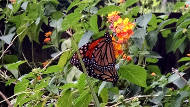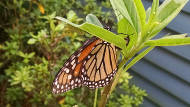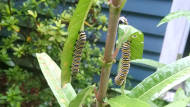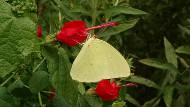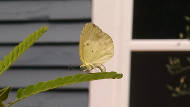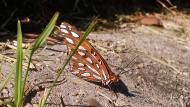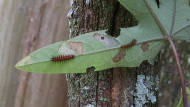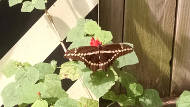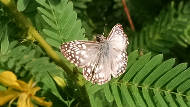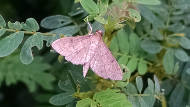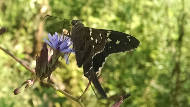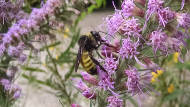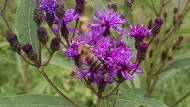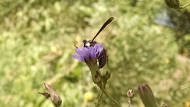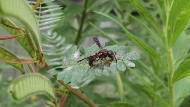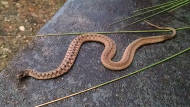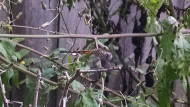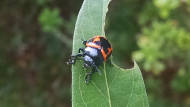A Better Sense of Place
2016 September 6 (Tue)
Insects are friends
It's taken a while, but the insects have arrived. I don't have a big variety of nectar and host plants yet, but I guess it's enough for now. Besides, it's a whole lot more than most of the other yards I've seen around Baton Rouge. I don't know how these insects survived the journey into the middle of Lawn Town, but they did it. It's now time to chase them around with a camera.
Monarchs
I'll start out with what is perhaps the most widely known endangered insect, the monarch butterfly (Danaus plexippus). I used to never see these butterflies in the yard. It was only when I put some milkweeds in the ground that they started hanging out. I haven't been able to get any milkweed growing except tropical milkweed (Asclepias curassavica), but so be it. The first picture above is of a mating pair. The male and female attach and fly around together for I don't know how long. Maybe an hour or so. At some time later, the female plops down eggs onto milkweed leaves like in the second picture. In the second and third pictures, you can see the caterpillars chomping away on the leaves.
Other butterflies
Cloudless sulphur butterflies (Phoebis sennae) have fallen in love with the partridge pea. They were here last year but are back in larger numbers this year. They were really hard to take pictures of, but I finally caught one drinking out of a Turk's cap flower (first picture). Then later, I found a teensy one laying eggs on partridge pea (second picture). Since it's smaller, I kinda figure it's another species, but who knows? The third picture is a Gulf fritillary (Agraulis vanillae). This was also hard to photograph because they would only circle around the maypop growing up the crepe myrtle. I caught this one warming up in the morning sun. The fourth picture is of two Gulf fritillary caterpillars, which were much easier to take pictures of. The fifth picture is the only non-blurry picture I could get of the two species of swallowtails fluttering around the yard. This one is a giant swallowtail. The spicebush swallowtail would only land on the lantana, and only for a few seconds. (The lantana is hard to get to.) (Another side note: I caught the spicebush swallowtail laying eggs on young leaves of a camphor tree from China. Who knew?)
Moths
It wouldn't be summer without moths, though. I don't know the names of these, so you'll have to look them up yourself. The first one has white spots. The second one doesn't. The third one was partial to woodland lettuce.
Wasps and bees
On to the wasps and bees. Bumblebees (first picture) have been particularly fond of the partridge pea and prairie blazing star. Honeybees have been a little less frequent this year for some reason (picture 2). And of course there are some wasps (pictures 3 and 4), and of course I don't know their names.
Miscellany
So I'll throw in a couple other animals. I saw this scared, inoffensive brown snake (Storeria dekayi) on the front steps one evening after some heavy rain. I haven't seen it since. For the second picture, I thought I'd throw in a completely out of focus dragonfly. And finally, the third picture is a milkweed leaf beetle (Labidomera clivicollis) on a tropical milkweed.
I see these butterflies flying around and around the yard. I could be wide-eyed and happy about it, but I'm pretty sure what's happening is they're looking for a larval host. They're looking for a plant that their babies can eat. Butterfly adults can feed on most flowers (more or less), but their babies are very particular. Monarchs are the best example of this, from what I understand: until just before they pupate (when they can also eat squash), they can only eat milkweed. Somehow, in their tiny pin-sized noggins, female butterfly adults know this and will fly all day to find the plants that their babies can eat. It's just a little bit sad to know that I and my neighbors don't have anything that can help them out.
